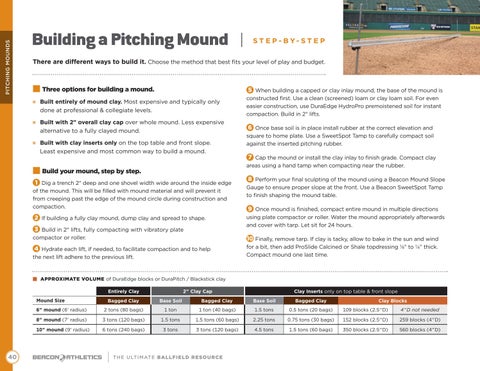PITCHING MOUNDS
Building a Pitching Mound |
S T E P - B Y- S T E P
There are different ways to build it. Choose the method that best fits your level of play and budget.
Three options for building a mound.
5 When building a capped or clay inlay mound, the base of the mound is
Built entirely of mound clay. Most expensive and typically only
done at professional & collegiate levels. Built with 2" overall clay cap over whole mound. Less expensive
alternative to a fully clayed mound. Built with clay inserts only on the top table and front slope.
Least expensive and most common way to build a mound.
constructed first. Use a clean (screened) loam or clay loam soil. For even easier construction, use DuraEdge HydroPro premoistened soil for instant compaction. Build in 2" lifts.
6 Once base soil is in place install rubber at the correct elevation and square to home plate. Use a SweetSpot Tamp to carefully compact soil against the inserted pitching rubber. 7 Cap the mound or install the clay inlay to finish grade. Compact clay areas using a hand tamp when compacting near the rubber.
Build your mound, step by step. 1 Dig a trench 2" deep and one shovel width wide around the inside edge of the mound. This will be filled with mound material and will prevent it from creeping past the edge of the mound circle during construction and compaction.
2 If building a fully clay mound, dump clay and spread to shape. 3 Build in 2" lifts, fully compacting with vibratory plate compactor or roller. 4 Hydrate each lift, if needed, to facilitate compaction and to help the next lift adhere to the previous lift.
8 Perform your final sculpting of the mound using a Beacon Mound Slope Gauge to ensure proper slope at the front. Use a Beacon SweetSpot Tamp to finish shaping the mound table.
9 Once mound is finished, compact entire mound in multiple directions using plate compactor or roller. Water the mound appropriately afterwards and cover with tarp. Let sit for 24 hours.
10 Finally, remove tarp. If clay is tacky, allow to bake in the sun and wind for a bit, then add ProSlide Calcined or Shale topdressing ⅛" to ¼” thick. Compact mound one last time.
APPROXIMATE VOLUME of DuraEdge blocks or DuraPitch / Blackstick clay Entirely Clay Mound Size
40
2" Clay Cap
Clay Inserts only on top table & front slope
Bagged Clay
Base Soil
Bagged Clay
Base Soil
Bagged Clay
6" mound (6' radius)
2 tons (80 bags)
1 ton
1 ton (40 bags)
1.5 tons
0.5 tons (20 bags)
109 blocks (2.5"D)
4"D not needed
8" mound (7' radius)
3 tons (120 bags)
1.5 tons
1.5 tons (60 bags)
2.25 tons
0.75 tons (30 bags)
152 blocks (2.5"D)
259 blocks (4"D)
10" mound (9' radius)
6 tons (240 bags)
3 tons
3 tons (120 bags)
4.5 tons
1.5 tons (60 bags)
350 blocks (2.5"D)
560 blocks (4"D)
|
T HE ULT I M AT E BA L L F I E L D R E S OUR C E
Clay Blocks
















